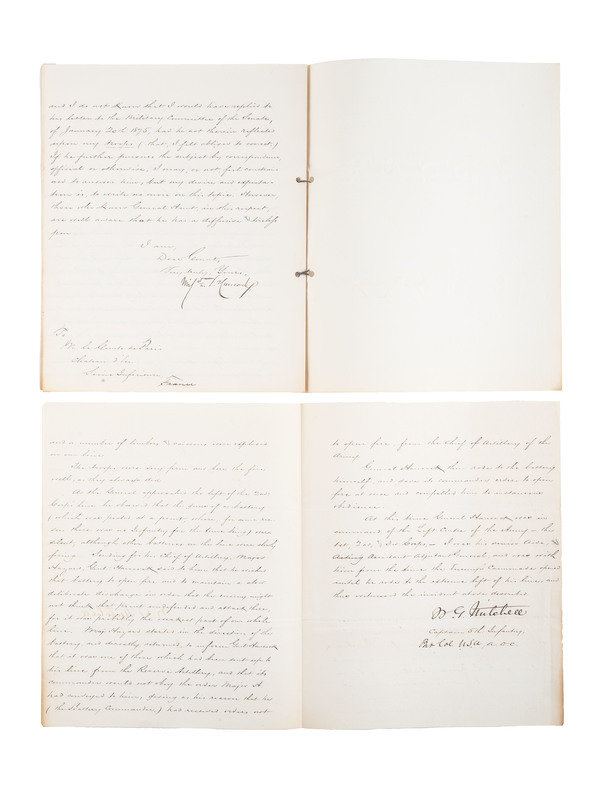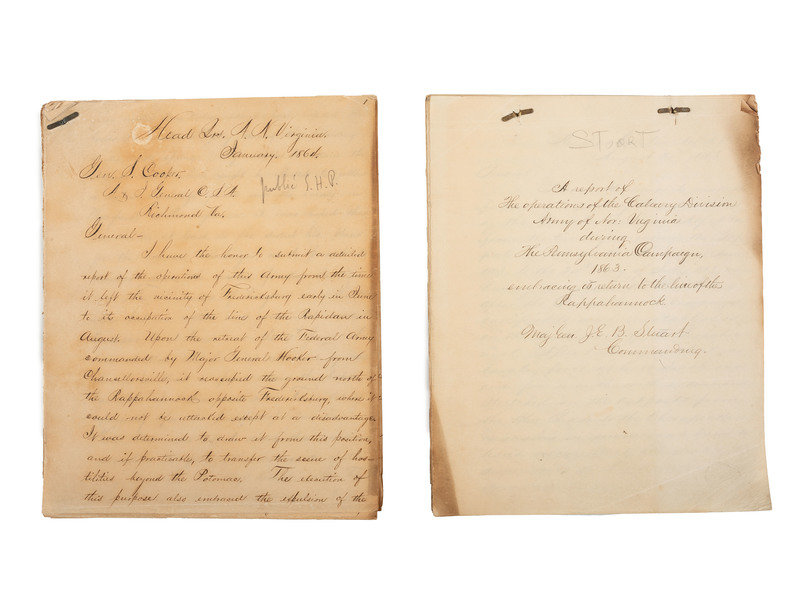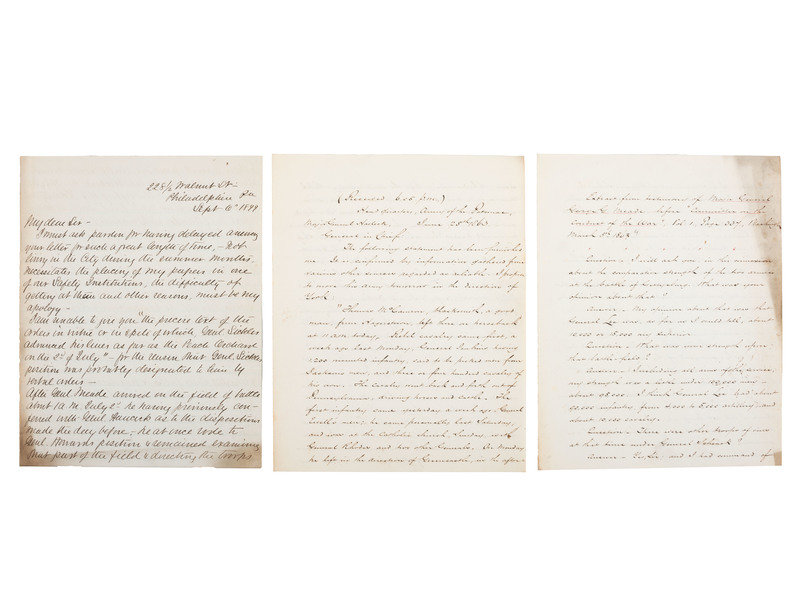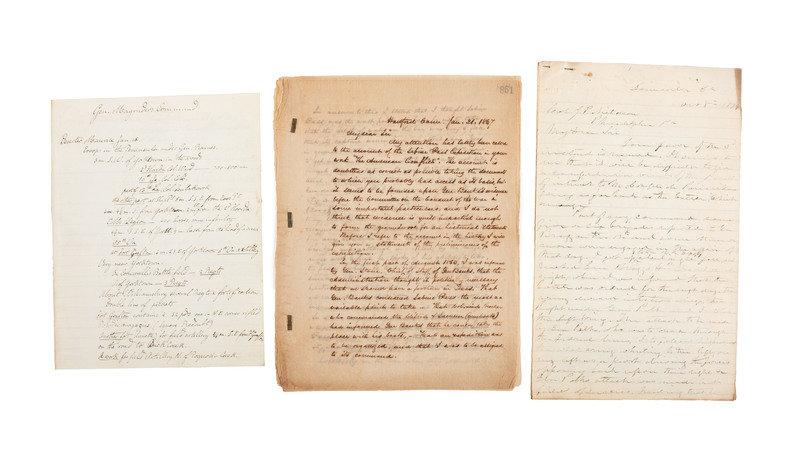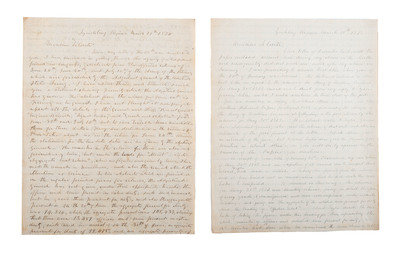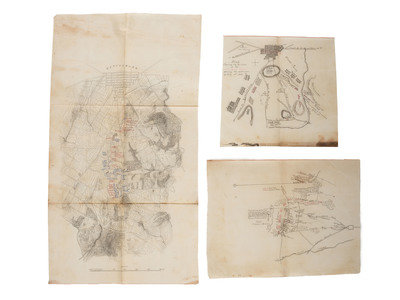Lot 102
[CIVIL WAR]. Military reports, maps, post-war letters from Union and Confederate officers, and other papers gathered by Union Army officer Louis-Philippe-Albert d'Orléans, comte de Paris (1838-1894), while conducting research for his book History of the Civil War in America.
Sale 1095 - American Historical Ephemera & Photography, Featuring Property from the James Milgram, M.D., Collection of Broadsides, Ephemeral Americana & Historical Documents
Day 1 Lots 1-403
Nov 3, 2022
10:00AM ET
Day 2 Lots 404-634
Nov 4, 2022
10:00AM ET
Live / Cincinnati
Own a similar item?
Estimate
$15,000 -
25,000
Price Realized
$18,750
Sold prices are inclusive of Buyer’s Premium
Lot Description
[CIVIL WAR]. Military reports, maps, post-war letters from Union and Confederate officers, and other papers gathered by Union Army officer Louis-Philippe-Albert d'Orléans, comte de Paris (1838-1894), while conducting research for his book History of the Civil War in America.
Approx. 116 documents spanning approx. 1857-1879 (bulk 1870s), constituting original bibliographical elements obtained and utilized by d'Orléans while researching and writing his influential account of the American Civil War. Archive primarily consists of copies of after-battle reports and maps, a small number of war-date documents, research notes, and post-war correspondence from prominent Civil War-era officers addressing the comte's questions pertaining to specific military engagements. High-ranking Union and Confederate generals are represented in the archive with approx. 15 ALS/LS addressed to d'Orléans from Civil War officers including Generals Jubal A. Early, Winfield S. Hancock, Henry Heth, William B. Franklin, William F. Smith, Emerson Opdycke, and J.D. Cox. Letters in the collection demonstrate the extent to which d'Orléans went to acquire primary sources and firsthand accounts of the conflict while also providing fascinating insight into how both northern and southern combatants assessed the war in the immediate decades following its cessation. Documents grouped, likely by a later caretaker of the collection, and housed in large sheets of paper folded in halves to act as folders. Condition generally good with expected toning and folds. A few letters faint, but legible. Provenance: Consignor relates that documents were purchased by a collector in Paris at Drouot ca 1960s then descended to that individual's daughter from whom the consignor acquired the lot.
Papers in the archive relate to multiple theaters of operation and reference numerous engagements in the Civil War including Fredericksburg, Franklin, Nashville, Wilmington, Mine Run, Manassas, Mill Spring, Sabine Pass, Brownsville, Chattanooga, New Berne, Great Bethel, White Oak Road, and more. Particularly extensive are research materials chronicling the Battle of Gettysburg, with approximately 1/4 of the documents in the archive related to the 3-day battle and the execution of the Pennsylvania Campaign. The preponderance of Gettysburg material suggests that the archive may represent research conducted in the late 1870s/early 1880s by the comte for his 3rd volume of the History of the Civil War in America which contained a detailed analysis of the battle and was published in the US in 1886.
Letters in the collection are notable for the detail and candor with which the correspondents describe for d'Orléans events in the war. In an 1877 ALS (9pp) from General George Meade's son, the younger Meade relays events pertaining to the Meade-Sickles controversy. Meade writes in part: "I am unable to give you 'the precise text of the orders in which or in spite of which Genl. Sickles advanced his lines as far as the Peach Orchard on the 2d of July' - for the reason that Genl. Sickles position was probably designated to him by verbal orders." Union General Winfield S. Hancock addresses the comte regarding the Hunt-Hancock controversy and the use of Union artillery at Gettysburg writing on 3 September 1879 (8pp) that "it was well understood at the time of the battle [of Gettysburg] that, the reserve supply of artillery ammunition, on the field, was insufficient to meet great demands, owing to the fact that, in accordance (it is presumed) with instructions from the Army Commander, or General Hunt, a portion of it was left in park (probably at Westminster, Md) as the army marched to Gettysburg." Confederate General Henry Heth writes to d'Orléans in March 1878 (two ALSs, 6pp and 4pp, respectively) regarding his troops at Gettysburg noting emphatically that "[his] division was the strongest division in the Army of Northern Virginia, by long odds stronger than three fourths of the divisions composing that army" and noting that he did not hesitate to assert "as a fact, that my effective strength was greater when we reached Gettysburg than it was when we left Fredericksburg...." In a lengthy ALS (27pp) of 19 October 1877 written to the comte by Jubal A. Early, the former Confederate officer takes issue with several points from the comte's previous letter and with representations made in the comte's already published volume. Early expounds upon the strength of the Confederate Army with which General Lee invaded Pennsylvania, questions the character of the fighting done by the Federal troops at Gettysburg, and elaborates on the role of England, France (including the comte's own ancestor "Regent, Duc d'Orleans"), and the northern states in the slave trade. Early prefaces his remarks asking, "Will you pardon me for saying that you can not have studied very carefully the two volumes of reports of the operations of the Army of Northern Virginia, mentioned in your Bibliographical note to your 1st volume (Am Ed.)." Early concludes his detailed analysis offering: "I beg to assure you that my criticisms on your first volume emanated from no feelings of a personal character, but were presented solely by my regard for a people and a cause you have wholly misunderstood, and about both of which you have written with great harshness and, as I conceive, injustice."
While Gettysburg is the subject of a larger portion of the correspondence, other engagements are addressed as well. Union General William B. Franklin writes to d'Orléans in November 1875 (ALS, 8pp) describing his antipathy for the "Committee on the Conduct of the War" and describing his part in the Sabine Pass Expedition. "I confess that I ought not to have gone on that expedition," Franklin writes, "But I felt that as I had lately been condemned by that Committee [on the Conduct of the War], another accusation of lukewarmness would be fatal, and after doing what I could in the way of protest, unavoidably, I thought there was nothing to do, but go, and went. Foolish as the expedition was, you will see that it did not have a fair chance, on account of the mismanagement of Banks's Staff Officers." Union General William F. Smith writes to the comte in September 1879 (ALS, 4pp) about the Chattanooga Campaign and his efforts to provide much-needed supplies in Chattanooga: "The day I arrived [in Tennessee] & reported to Rosencrans I told him it would be impossible for him to supply his army by the mountain after the rainy weather set in. At this he laughed and showed me the amount of forage & rations he was accumulating. I however set to work at once to fortify Chattanooga so that it could be held by a small force and repeatedly as our provisions grew scarce spoke to the General about some way of opening the river." General S. Emerson Opdycke writes to the comte in January 1877 (ALS, 6pp) detailing his role and that of Generals David S. Stanley and J.D. Cox in the Battle of Franklin. In regards to Stanley's role at the battle for which Stanley received the Medal of Honor, Opdycke seems less than convinced that the honor was warranted: "I am glad to state that he manifested the true military spirit in coming on to the battlefield, but it would not be true to say that he, in the least, influenced events...His official report is very unjust to General Cox, because Stanley did not assume any commands, nor did he give any orders, and I am sure he was not in the battle five minutes."
Correspondence related to the war but not addressed directly to d'Orléans is also contained in the archive. Letters indicate that d'Orléans used intermediaries at times to convey specific inquiries and requests for firsthand accounts of the conflict. Copies of the requested replies and some original replies seem to then have been furnished to the comte for his research. Several letters in the collection from Confederate officers were addressed to the Secretary of the Southern Historical Society, the Rev. J. William Jones, a former Confederate chaplain who led efforts to preserve archival material related to the Confederacy and document the history of the Civil War from the perspective of the South. (A few documents in the archive bear the pencil notation "Public SHP" likely indicating "Southern Historical Papers" copied from the collections of the Southern Historical Society.) Another such intermediary was Union Col. John Page Nicholson who served as an editor on the 3rd volume of the comte's History published in the US. Particularly notable is an October 1879 ALS (8pp) from Confederate Gen. James Longstreet to Nicholson, both participants in the Battle of Gettysburg, in which Longstreet attempts to explain "why Lookout Valley was so feably defended." Longstreet describes Confederate movements in East Tennessee in the fall of 1863 with references to Generals Bragg, Thomas, Hooker and to President Jefferson Davis, noting: "I doubt if General Bragg ever saw that his position at Chattanooga was weak even after he was driven from it. He certainly indicated entire confidence in it when I parted with him after I had explained that his lines of six or seven miles circumference could not be held against an army in the center, able to attack or [fire?] against any and every point of the circumference."
[With:] A small number of maps, likely post-war copies, accompany the archive including: "Field Works at Franklin, Tenn. Ocupied [sic] by the 23 and 4th Corps during engagements of Nov. 30th 1864"; "Copy of a Map furnished to Maj. Gen. G.K. Warren, Commanding The Fifth Army Corps by means of which to conduct operations beginning on March 29th, 1865"; "Map Showing the Positions of the 12th Army Corps during the afternoon of July 2d 1863"; "Sketch showing position held by Birney's Division during action near Gettysburg on the 2d of July 1863"; an undated topographical map of Gettysburg with handwritten ink notations on troop locations; and "Map of Country in Vicinity of Brown's Ferry made to accompany report of Brigadier General Wm. F. Smith, Chief. Engr. Department of the Cumberland" with handwritten note at bottom of map "This tracing has been forwarded to me from the Engr. Bureau since the receipt of the letter of Sept. [illegible] [signed] Wm. F. Smith." -- More than 20 operations and after battle reports, being a mix of both Union and Confederate, most appearing to be post-war copies, acquired by d'Orléans for research purposes, including in part: General Robert E. Lee's report to Gen. Samuel Cooper on the Pennsylvania Campaign;
General J.E.B. Stuart's report on the operations of the cavalry division Army of Northern Virginia during the Pennsylvania Campaign; General A.A. Humphrey's report of the part taken by the 2nd Division 3rd Army Corps in the campaign from 11 June to 9 July 1863; General J.D. Cox's reports on operations of the 3rd Division of the 23rd Army Corps during the operations in front of Wilmington in February 1865; report of General J.D. Cox of the movements and engagements of the 3rd Division 23rd Army Corps from the 22nd to the 29th of November, the Battle of Nashville; and General J.D. Cox's report on the operations of the Provisional Corps under his command from 1 March 1865 to the occupation of Goldsboro.
[With:] A group of three November 1863 broadsides, all in Spanish, tipped in to a large period ledger inscribed on the front flyleaf "Col. Wilson ADC" [presumably Col. James Grant Wilson, aide-de-camp to Gen. Nathaniel P. Banks] and on the following page "General Banks / Expedition to the Rio Grande / Texas - Nov 1863." The broadsides relate to the Battle of Brownsville and its aftermath in which civil unrest erupted following the rapid retreat of Confederate troops. Two are signed in type by exiled Mexican General Jose Maria Cobos who secured the city of Brownsville and turned it over to Union troops before crossing into Matamoros where he declared himself governor on November 6. The other is signed in type by Juan Nepumuseno Cortina who had Cobos killed on November 7th. OCLC locates no other copies of the broadsides signed by Cobos, and only one copy of the broadside signed by Cortina. The broadside "Jose Maria Cobos Gral. Dedivision del Ejercito Mejicano, a Sus Companeros de Armas" (General Jose Maria Cobos of the Division of the Mexican Army to her Comrades in Arms") bears the handwritten pencil notation in English script at bottom, "Nov. 7th 1863 Cobos was shot this morning at 8AM." The remainder of the ledger contains approx. 20 war-date newspaper clippings about Banks's Expedition, Texas, and the political situation in Mexico.
[Also with:] An undated 17pp manuscript document "Literature of the 'Civil War'" which identifies the author, title, size, number of pages, and price for well over 200 works; a "List of Books sent to the Count of Paris through Major Genl Humphreys Chief of Engineers U.S.A."; a hand-drawn diagram "Army of Northern Virginia as re-organized into three corps, after the 31st of May 1863, and before the commencement of the Pennsylvania Campaign," and a small number of miscellaneous imprints, newspaper clippings, manuscript copies of newspaper reports from the war, and manuscript copies of narratives from the war.
A RARE AND SUBSTANTIVE ARCHIVE FROM A WOULD-BE-KING TURNED CIVIL WAR SOLDIER
Louis-Philippe-Albert d'Orléans, often referred to in the United States as Phillippe d'Orléans, Count of Paris, was the grandson of French King Louis Phillippe I and pretender to the throne after the deaths of his grandfather and father. Exiled to England in 1848 after the fall of the French monarchy, he later elected to serve the Union cause. Phillippe d'Orléans was appointed as assistant adjutant general with the rank of captain in September 1861 and served on the staff of Major General George B. McClellan in the Army of the Potomac. Prior to resigning in July 1862, d'Orléans served with distinction in the Peninsular Campaign. His multi-volume Histoire de la Guerre Civile en Amérique was first published in France between 1874-1896. In 1875, the first volume of English translation was published in the United States, with later volumes appearing in 1876, 1883, and 1888. Regarded by many in its time as a balanced, thorough, and authoritative piece of scholarship, the History of the Civil War in America remains a standard reference work on the American Civil War still today.
Condition Report
Contact Information
Auction Specialist




